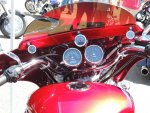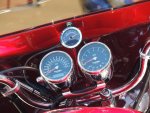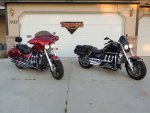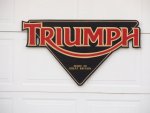Idaho Red Rocket 3
Living Legend
- Joined
- Nov 22, 2008
- Messages
- 5,590
- Location
- Nampa, Idaho USA
- Ride
- 2006 RIII Standard Bagger w/Fairing
I wanted to give the Forum Members some information about the Dobeck Performance AFR Plus I recently installed on my 2006 Standard Rocket III. This add-on performance enhancement system is a plug and play devise that controls the fuel system at the injectors. No computers or dyno tuning is required. The devise is safe because the rider can control the fuel injection Air Fuel Ratio on the AFR readout gauge that comes with the devise. The simple controls can change the setting anytime the rider chooses. And you can change the settings as you change your riding style and any intake or exhaust changes that may be desired. The device has 3 fuel settings and a fuel pump setting. There are several switch point settings as well. All are adjustable at the touch of 3 buttons on the AFR gauge face. I wanted to compare the results of this device to the result achievable with TuneECU, a computer, and a trip to the dyno.
I have two 2006 Rocket III motorcycles. My red standard you see in my avatar and a Classic recently purchased for $3000 due to the popping out of second gear problem. (The Classic is another couple of stories for several other posts later.) The standard has stock tune 20226, stock under seat air filter with snorkel removed, stock exhaust with cat eliminator pipe. The Classic came with TuneECU installed but not optimized. I found tune 20219 installed. It too has the stock under seat air filter with snorkel removed, but it has the D&D slip on 3-1-2 exhaust and no cat. D&D claims this mod alone ads something about 8 to 10 HP and TQ. The previous owner had an extra baffles made for it to tone down the noise. (Really sounds good.)
Saturday my son and I took both Rockets to see Glenn at Motor Mayhem in Meridian, Idaho. Glenn is one of the owners and can be reached at 208-887-2058. He has a 2 large roller DynoJet dyno that can do motorcycles and cars. I asked Glen how his numbers compare to others dyno numbers. He said his customers tell him his dyno is “conservative” and is considered to be as close to actual as is available in our area. He told me some of his customers take their vehicle to some of the other dyno places around the valley to get higher number printouts so they can have better bragging rights. I also asked Glen if those 2 big rollers were going to create a false number for my motorcycles. He said “it would be like pulling a trailer up a steep long grade with a fat girl sitting on the back seat. In essence it will give the bike a good workout under load and report very accurate numbers”. I also asked Glenn about the effects of our altitude. He said not only our altitude reduces power but so does our “poor” air quality. It is very dry with very fine dust in the air here. The power loss can be anywhere from 10 to 15 percent. The print out will have an SAE number that is used to calculate the Sea Level equivalent power.
First up is the Classic with TuneECU already installed. I made a few settings changes before the run. Increased idle to 960 RPM, max RPM to 6700, increased max KPH to 299, and reduced fan start temp to 98C. I believe these changes have little to no effect on the HP and TQ. We did 7 runs and I will give you the results of the 5 that matter. On 2 of the 7 runs we tried some ideas that only reduced power, so I’ll skip those.
Classic Runs: Stock intake / D&D 3-1-2 slip on exhaust. Time was 10AM to 11:10 AM. Temps started at 83 degrees and went up to 88 degrees. Humidity started at 23% and went down to 20%.
1) Tune 20219 with 2nds at 100%. HP 116.29 TQ 146.00.
2) Tune 20219 with 2nds at 75% at 2250 to 3750 RPM. HP 127.27 TQ 145.32.
3) Tune 20228 Power-TrippR3 TORS underseat decel with 2nds at 100%. HP 130.52 TQ 148.18.
4) Tune 20050 with 2nds at 100%. HP 130.84 TQ 151.39.
5) Tune 20050 with 2nds at 75% at 2500, 2750 and 4500 RPM. HP 130.76 TQ 151.51.
Using just TuneECU we see an increase from tune 20219 to tune 20050. HP+ 14.47 TQ+ 5.51. I find it interesting how closing down the secondaries some in the mid-range increase power a bit. We made run number 5 the final tune. With the 12% SAE factor printed on the report, the power adjusted to Sea Level is HP 146.45 TQ 169.70.
Now we hook up the Standard bike which has the Dobeck Performance AFR Plus. Since I have TuneECU and know how to use it, I made the same changes on this bike, increased idle to 960 RPM, max RPM to 6700, Max KPH to 299 and reduced fan start temp to 98C. I believe these changes have little to no effect on the HP and TQ. We did 8 runs and I will give you the results of the 3 that matter. We tried several runs just adjusting the AFR Plus, but determined the settings Mark Dobeck set it at last April were the best. So we put it back to those numbers for the remainder of the test runs.
Standard Runs: Stock intake / Stock exhaust with cat delete pipe. Time was Noon to 1:35 PM. Temps started at 92 degrees and went up to 95 degrees. Humidity started at 17% and went down to 12%. About 2 years ago we ran the bike without the AFR Plus and got these numbers. HP 119.76 and TQ 136.22. (About - from memory. My dyno sheet is on the wall at my office.)
1) Tune 20226 stock tune with 2nds closed down to 91% to as low as 34% from 1709 RPM to 4000 RPM. Most way points are 43% or less in the mid-range. HP 138.16 TQ 145.26. Nice increase over bone stock.
2) Tune 20226 stock tune with 2nds at 75% from 1978 to 3750 RPM. HP 139.20 TQ 151.96. Better.
3) Tune 20050 with 2nds at 75% at 2500, 2750 and 4500 RPM. HP 140.18 TQ 155.34. Best.
Since I have the TuneECU, we made run number 3 the final tune. With the 13% SAE factor printed on the report, the power adjusted to Sea Level is HP 158.40 TQ 175.53.
So here is my take on the Dobeck Performance AFR Plus. No computer needed. No dyno tuner needed. Fully adjustable and safe with Air Fuel Ratio read out in real time. Comparing my standard bike with stock tunes with and without AFR Plus, the bike gained 19 horsepower and 9 ft. lbs. torque with AFR Plus.
Bill.
I have two 2006 Rocket III motorcycles. My red standard you see in my avatar and a Classic recently purchased for $3000 due to the popping out of second gear problem. (The Classic is another couple of stories for several other posts later.) The standard has stock tune 20226, stock under seat air filter with snorkel removed, stock exhaust with cat eliminator pipe. The Classic came with TuneECU installed but not optimized. I found tune 20219 installed. It too has the stock under seat air filter with snorkel removed, but it has the D&D slip on 3-1-2 exhaust and no cat. D&D claims this mod alone ads something about 8 to 10 HP and TQ. The previous owner had an extra baffles made for it to tone down the noise. (Really sounds good.)
Saturday my son and I took both Rockets to see Glenn at Motor Mayhem in Meridian, Idaho. Glenn is one of the owners and can be reached at 208-887-2058. He has a 2 large roller DynoJet dyno that can do motorcycles and cars. I asked Glen how his numbers compare to others dyno numbers. He said his customers tell him his dyno is “conservative” and is considered to be as close to actual as is available in our area. He told me some of his customers take their vehicle to some of the other dyno places around the valley to get higher number printouts so they can have better bragging rights. I also asked Glen if those 2 big rollers were going to create a false number for my motorcycles. He said “it would be like pulling a trailer up a steep long grade with a fat girl sitting on the back seat. In essence it will give the bike a good workout under load and report very accurate numbers”. I also asked Glenn about the effects of our altitude. He said not only our altitude reduces power but so does our “poor” air quality. It is very dry with very fine dust in the air here. The power loss can be anywhere from 10 to 15 percent. The print out will have an SAE number that is used to calculate the Sea Level equivalent power.
First up is the Classic with TuneECU already installed. I made a few settings changes before the run. Increased idle to 960 RPM, max RPM to 6700, increased max KPH to 299, and reduced fan start temp to 98C. I believe these changes have little to no effect on the HP and TQ. We did 7 runs and I will give you the results of the 5 that matter. On 2 of the 7 runs we tried some ideas that only reduced power, so I’ll skip those.
Classic Runs: Stock intake / D&D 3-1-2 slip on exhaust. Time was 10AM to 11:10 AM. Temps started at 83 degrees and went up to 88 degrees. Humidity started at 23% and went down to 20%.
1) Tune 20219 with 2nds at 100%. HP 116.29 TQ 146.00.
2) Tune 20219 with 2nds at 75% at 2250 to 3750 RPM. HP 127.27 TQ 145.32.
3) Tune 20228 Power-TrippR3 TORS underseat decel with 2nds at 100%. HP 130.52 TQ 148.18.
4) Tune 20050 with 2nds at 100%. HP 130.84 TQ 151.39.
5) Tune 20050 with 2nds at 75% at 2500, 2750 and 4500 RPM. HP 130.76 TQ 151.51.
Using just TuneECU we see an increase from tune 20219 to tune 20050. HP+ 14.47 TQ+ 5.51. I find it interesting how closing down the secondaries some in the mid-range increase power a bit. We made run number 5 the final tune. With the 12% SAE factor printed on the report, the power adjusted to Sea Level is HP 146.45 TQ 169.70.
Now we hook up the Standard bike which has the Dobeck Performance AFR Plus. Since I have TuneECU and know how to use it, I made the same changes on this bike, increased idle to 960 RPM, max RPM to 6700, Max KPH to 299 and reduced fan start temp to 98C. I believe these changes have little to no effect on the HP and TQ. We did 8 runs and I will give you the results of the 3 that matter. We tried several runs just adjusting the AFR Plus, but determined the settings Mark Dobeck set it at last April were the best. So we put it back to those numbers for the remainder of the test runs.
Standard Runs: Stock intake / Stock exhaust with cat delete pipe. Time was Noon to 1:35 PM. Temps started at 92 degrees and went up to 95 degrees. Humidity started at 17% and went down to 12%. About 2 years ago we ran the bike without the AFR Plus and got these numbers. HP 119.76 and TQ 136.22. (About - from memory. My dyno sheet is on the wall at my office.)
1) Tune 20226 stock tune with 2nds closed down to 91% to as low as 34% from 1709 RPM to 4000 RPM. Most way points are 43% or less in the mid-range. HP 138.16 TQ 145.26. Nice increase over bone stock.
2) Tune 20226 stock tune with 2nds at 75% from 1978 to 3750 RPM. HP 139.20 TQ 151.96. Better.
3) Tune 20050 with 2nds at 75% at 2500, 2750 and 4500 RPM. HP 140.18 TQ 155.34. Best.
Since I have the TuneECU, we made run number 3 the final tune. With the 13% SAE factor printed on the report, the power adjusted to Sea Level is HP 158.40 TQ 175.53.
So here is my take on the Dobeck Performance AFR Plus. No computer needed. No dyno tuner needed. Fully adjustable and safe with Air Fuel Ratio read out in real time. Comparing my standard bike with stock tunes with and without AFR Plus, the bike gained 19 horsepower and 9 ft. lbs. torque with AFR Plus.
Bill.
Attachments
Last edited:




